Air travel has exploded in popularity in the century since the first airline was established in 1914. Since then, thousands of airports have been constructed all over the world to meet ever-increasing demands, and they’ve had to continually grow larger and more sophisticated.
Today, the largest airports in the world are massive. Many of them are also expected to increase in size in the near future due to expansion projects. In this post, we’ll look at the ten biggest airports in the world by total size. We’ll also examine the types of facilities these airports have along with some fascinating statistics.
The table below lists the world’s largest airports by size in total square kilometers and square miles.
| Rank | Airport | Size in km2 (mi2) |
| 1 | King Fahd International, Saudi Arabia | 776 (299.6) |
| 2 | Denver International, U.S. | 135.7 (52.4) |
| 3 | Dallas Fort Worth International, U.S. | 69.5 (26.8) |
| 4 | Orlando International Airport, U.S. | 53.8 (20.8) |
| 5 | Washington Dulles International Airport, U.S. | 48.6 (18.8) |
| 6 | Beijing Daxing International Airport, China | 46.6 (18) |
| 7 | George Bush Intercontinental Airport, U.S. | 44.5 (17.2) |
| 8 | Shanghai Pudong International Airport, China | 39.9 (15.4) |
| 9 | Cairo International Airport, Egypt | 36.3 (14) |
| 10 | Suvarnabhumi International Airport, Thailand | 32.4 (12.5) |
10. Suvarnabhumi International Airport
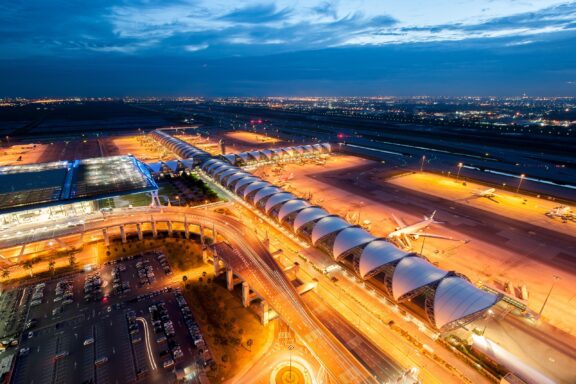
Country: Thailand
Size: 32.4 sq km (12.5 sq mi)
Official Website: Suvarnabhumi Airport
Unofficially known as Bangkok International Airport, Suvarnabhumi is one of two international airports near Bangkok, the capital of Thailand. The name Suvarnabhumi is Sanskrit and translates to “golden land” in English.
Suvarnabhumi has been Thailand’s largest airport since it first officially opened in 2006 when it replaced Bangkok’s older Don Mueang International Airport as the main airport of the city. Don Mueang in Bangkok is still an operating airport and is currently primarily home to several low-cost airlines.
Like other very large airports, Suvarnabhumi is equipped to offer a wide array of services and amenities to travelers, such as free Wi-Fi, lounges, restaurants, cafes, and duty-free shops. The airport has accommodated more than 60 million passengers in a year and has connections with more than 60 different countries.
Located about 25 km (15.5 mi) from downtown Bangkok, Thailand’s largest airport is well connected to the capital city. It’s possible to take a taxi or car to the city, and the Airport Rail Link (ARL) takes about 30 minutes to bring passengers downtown.
Not only is Suvarnabhumi an important airport for Thailand, but it’s also one of the most important international airports in Southeast Asia, acting as a gateway to the area. In 2019, it was the second-busiest airport in the region after Changi Airport in Singapore.
9. Cairo International Airport
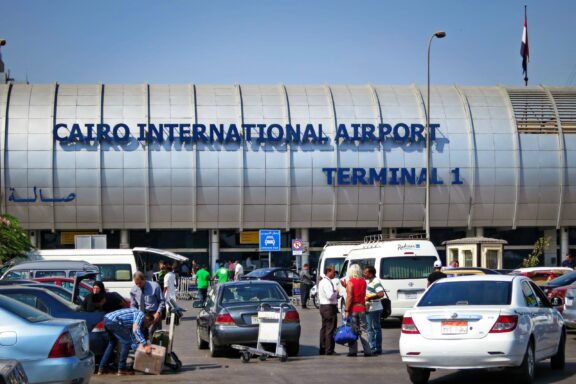
Country: Egypt
Size: 36.3 sq km (94 sq mi)
Official Website: Cairo International Airport
The largest and busiest airport in Egypt is Cairo International Airport, which is also the ninth-largest in the world. The airport is located about 15 km (9.3 mi) from Cairo, the capital of Egypt. As well as the primary international travel gateway to Egypt, the airport functions as a major regional transportation hub.
Cairo International Airport is one of the busiest airports in Africa, and it has four terminals to serve passengers. Terminal 1 serves many domestic flights but also has connections with international airlines. Terminal 2 is served by a number of international, especially Middle Eastern, airlines, and Terminal 3 is served by European airlines and a few others.
Of the many airlines that travel to and from Cairo International Airport, the Egyptian airlines EgyptAir and Nile Air both use the airport as their primary hub. Others that use this airport as a hub are Air Arabia Egypt, Air Cairo, and AlMasria Universal Airlines.
Construction on Cairo’s international airport began in 1957, and it was officially inaugurated in 1963. Air traffic dramatically increased during the following two decades, requiring the construction of a second terminal to meet demands. A third terminal was opened in 2009 to meet increasing demand.
8. Shanghai Pudong International Airport
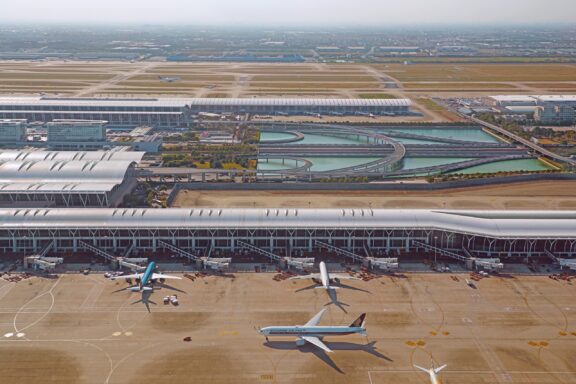
Country: China
Size: 39.9 sq km (15.4 sq mi)
Official Website: Shanghai Pudong International Airport
Shanghai has a population of more than 25 million, and it is served by two international airports. Shanghai Pudong International Airport (PVG) is the larger of the two and the eighth largest in the world by size.
PVG serves most international flights but also accommodates some domestic flights, while the city’s other airport, Shanghai-Hongqiao, mostly operates domestic and regional flights. The two terminals at PVG are capable of handling up to 80 million passengers annually after several expansions.
Among the many airlines that frequent this airport, it is a major hub for China Eastern Airlines, Shanghai Airlines, and Air China. It’s also an important cargo hub in the area for shipping companies like FedEx, DHL, and UPS.
Roughly half of the passenger traffic at PVG is international, helping to make it China’s busiest international airport. Visitors arriving in Shanghai can access the city in just eight minutes via the Shanghai Transrapid maglev train, and the airport is also connected to the Shanghai Hongqiao Airport via the metro.
Its role as China’s busiest international airport and easy access to Shanghai as well as other major cities in the region make PVG an important airport on the Asian continent.
7. George Bush Intercontinental Airport
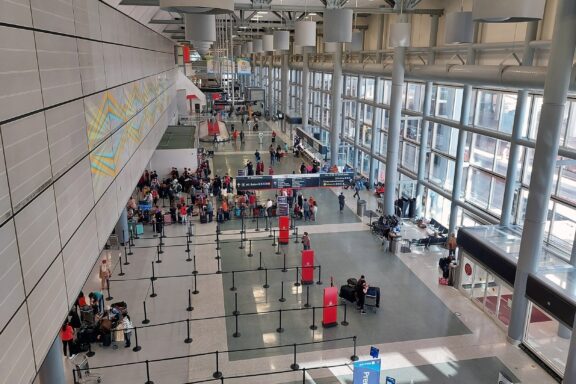
Country: United States
Size: 44.5 sq km (17.2 sq mi)
Official Website: George Bush Intercontinental Airport
George Bush Intercontinental Airport (IAH) is an international airport located in the state of Texas in the USA. It was first opened in 1969 and is situated 37 km (23 mi) north of the city of Houston. Originally named the Houston Intercontinental Airport, IAH was renamed in honor of former US president George H. W. Bush in 1997.
One of the largest airports in the United States, IAH facilitates flights to international destinations on five continents. It served more than 45 million passengers in 2019 and has the most international traffic and destinations of any airport in Texas.
IAH consists of five terminals which are all connected to each other airside by the Skyway, and landside connections to and from the terminals to the airport hotel can be made via subway. The airport provides many modern amenities such as free Wi-Fi, currency exchange services, a pet relief area, baggage storage, and much more.
Harmony in the Air is a performing arts program put on by Houston Airports that features live music from top musicians in the city. There is also a large collection of public art by Texan artists that is on display throughout the airport’s terminals and grounds.
6. Beijing Daxing International Airport

Country: China
Size: 46.6 sq km (18 sq mi)
Official Website: Beijing Daxing International Airport
China’s largest airport and the sixth-largest in the world is Beijing Daxing International Airport (PKX), located on the border of Langfang and Beijing, the capital of China. The airport was recently constructed, opening in 2019, and features the world’s largest single-building airport terminal, measuring 700,000 m2 in size.
Beijing Daxing utilizes four civilian runways and one military runway, and it’s the only airport in the world to have double-deck departure and arrival platforms. The building’s massive structure is inspired by traditional Chinese architecture and consists of a central point connected to six arms. Its nickname is “the starfish” because of its shape.
The opening of Beijing Daxing in 2019 coincided with the closing of the Beijing Nanyuan Airport, which was the oldest airport in China. PKX is the hub for China United Airlines as well as China Eastern Airlines and China Southern Airlines.
Some sustainable engineering concepts have been used in the construction of Beijing Daxing, such as a solar farm and a 100% rainwater collection system. At least 10% of the airport’s energy is produced from renewable sources.
5. Washington Dulles International Airport
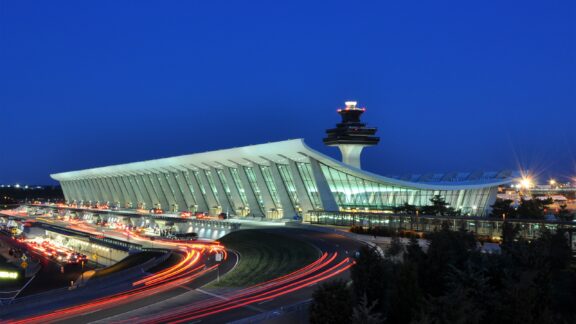
Country: United States
Size: (18.8 sq mi)
Official Website: Washington Dulles International Airport
The Washington Dulles International Airport (IAD) is located in the US state of Virginia, about 16.1 km (10 mi) from downtown Washington DC. The airport was opened in 1962 and is named after former US Secretary of State John Foster Dulles. It is one of the biggest airports in the world with an area of about 12,000 acres.
IAD is especially busy with international flights and is responsible for more international air traffic than any other airport in the Mid-Atlantic region outside of the New York Metro Area. More than 20 million passengers took flights through IAD in 2022.
The airport consists of a main terminal designed by famous architect Eero Saarinen and two midfield terminal buildings called Concourse A/B and Concourse C/D. The main terminal’s design, with a suspended roof and unique curved shape, is iconic, and it houses a notable art collection.
There are 113 airline gates at IAD, and the airport is a hub for Southern Airways Express and United Airlines. The busiest domestic routes to and from IAD include Denver, Colorado and San Francisco, California. The busiest international route is to and from San Salvador, El Salvador.
4. Orlando International Airport
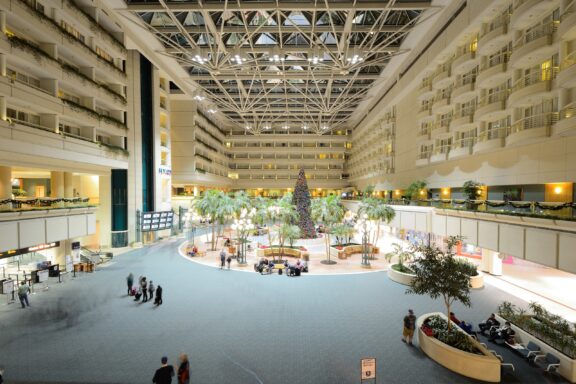
Country: United States
Size: 53.8 sq km (20.8 sq mi)
Official Website: Orlando International Airport
The largest airport in the state of Florida and the fourth-largest in the world is Orlando International Airport (MCO). It’s located just 10 km (6 mi) southeast of downtown Orlando, one of the biggest cities in Florida.
MCO is the second-busiest airport in Florida, receiving more than 130,000 passengers each day and just under 50 million annually. There are 39 airlines that use this airport, 33 of which are passenger airlines. It is the hub for Silver Airways, a regional airline, and a hub for others like JetBlue, Southwest Airlines, and Spirit Airlines.
The airport code MCO comes from “McCoy Air Force Base,” the former name of the airport. This was the name of a Strategic Air Command installation that was closed after the Vietnam War ended in 1975.
There is a large main terminal building that is divided into Terminal A on the north side and Terminal B on the south side. These terminals offer access to four airside concourses and 93 gates. There’s also Terminal C, which is located in the south terminal complex with 15 gates.
3. Dallas Fort Worth International
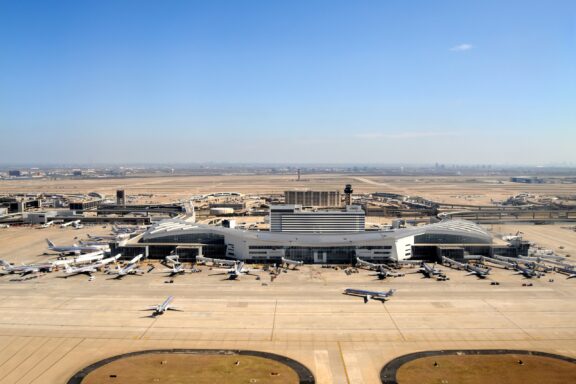
Country: United States
Size: 69.5 sq km (26.8 sq mi)
Official Website: Dallas Fort Worth International
The Dallas Fort Worth International Airport (DFW) is the third-largest in the world, and it’s also one of the busiest, with the second-most total passengers in 2021. DFW is located in North Texas and was opened for business in 1974.
DFW is so large that it has many of the same features of a city, such as its own postal code and city designation as well as police, fire, emergency, and medical departments. The airport consists of five terminals and 168 gates, and it’s the largest carbon-neutral airport in the world.
There are many airlines that operate at DFW, and the airport is a hub for American Airlines and Southern Airways Express as well as some cargo airlines. The airport’s busiest destination routes are to Los Angeles, California and Las Vegas, Nevada. The busiest international destinations are to Cancún, Mexico and London-Heathrow, United Kingdom.
When DFW opened in 1974, it was the largest airport in the world and it was named the Dallas Fort Worth Regional Airport until 1985. The airport was also the first to use an automated people mover, the Vought Airtrans. There are plans to construct a sixth terminal, but the timeline of these plans has been in flux since the COVID-19 pandemic.
2. Denver International
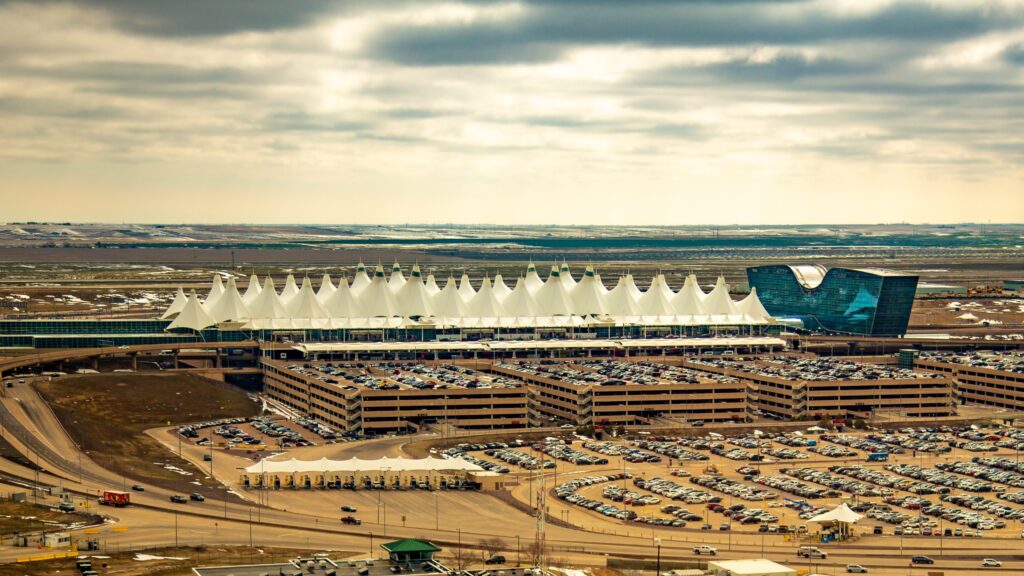
Country: United States
Size: 135.7 sq km (52.4 sq mi)
Official Website: Denver International
The largest airport in North America is Denver International Airport (DEN), the second-largest in the world. It also features the continent’s longest commercial runway with a length of 4.88 km 3.03 mi. DEN is located in the state of Colorado in the Western United States and primarily serves the city of Denver.
The design of the Denver International Airport is unique and iconic. The tent-like roof structure that covers the main terminal echos the peaks of the nearby Rocky Mountains and pays homage to the teepees that were located across the Great Plains by Native Americans.
There is a variety of art on display in the airport, and temporary art exhibits are frequently on display. Public art pieces related to the history of Colorado are also on display on the airport’s underground train.
DEN is a hub for United Airlines, Frontier Airlines, Denver Air Connection, and Southern Airways Express. There are several other airlines that operate at the airport, and non-stop flights to more than 200 different destinations are available.
This airport has won a number of awards, including Best Large Airport by US Today Readers’ Choice Award in 2021 and it was recognized for “Excellence in Service and Support” in the 2020 Frontier Awards, particularly for its COVID relief packages.
1. King Fahd International
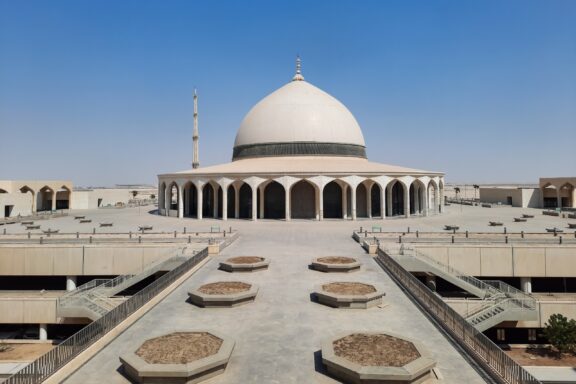
Country: Saudi Arabia
Size: 776 sq km (299.6 sq mi)
Official Website: King Fahd International Airport
It may not be the busiest airport in the world, but it’s certainly the biggest. The largest airport in the world is King Fahd International Airport (DMM), and second place doesn’t even come close. The airport is situated 31 km (19 mi) northwest of the center of Dammam in Saudi Arabia and is sometimes referred to as Dammam Airport.
One of three primary international airports in Saudi Arabia, Dammam Airport serves the kingdom’s entire Eastern Province. There are about 27 airlines operating here, and it is a hub for Flynas, Saudia, and Aramco Aviation. These airlines connect the city of Dammam with Europe, South/Southeast Asia, and the Middle East.
The airport is currently designed to be capable of handling up to 12 million passengers per year, though future expansions are planned to bring this capacity up to 16 million. There’s also a residential community of 3,000 people on the airport’s massive land area, as well as a mosque with a capacity for 2,000 worshippers.
DMM is on land that was formerly used as a US Air Base during the Gulf War. It opened for commercial activity as DMM in November of 1999 and subsequently replaced Dhahran International Airport as the primary airport in the region.